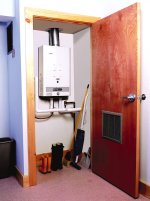Search engine visitors - click here to access entire "$ensible Home" web site
Click here to see a descriptive illustration showing several designs of instantaneous water heaters.
Dear Jim: We run out of hot water many mornings. I know a tankless water heater costs more to install than a standard one, but will a small tankless model really provide enough hot water for endless showers? - Lynn E.

A: A gas or electric tankless water heater can not only provide enough hot water for 20 consecutive showers in the morning, but it does this more efficiently than a standard tank-type water heater. An average-size family should notice $50 to $100 annual savings on its utility bills.
Some tankless water heaters can cost twice as much as a standard water heater, but the savings will pay back the higher cost. Since there is no tank to rust out, tankless water heaters have a very long life. They can also be repaired when a part wears out as opposed to a standard one which must be replaced every 10 or 15 years when the tank rusts out and leaks.
A lower-cost option is to install just a tiny point-of-use tankless water heater in the water pipe at the main shower or bathroom faucet. The electric ones are easiest to install in a bathroom. Some models operate on standard 110 volts, but the more powerful models use 220 volts. Some have digital controls that monitor the temperature up to 120 times per second.
Unlike older tankless water heaters, new ones with solid-state controls maintain a steady hot water temperature. This is accomplished by using variable gas burners or multiple-step electric heating elements which vary the heat output depending on how much hot water is being used at the time.
It is important to understand how a tankless water heater works to determine if one is your best choice. When someone opens a hot water faucet, the tankless water heater senses this and starts the gas burner or the electric heating elements. This heats the water as it flows through.
Gas models provide the greatest amount of hot water, up to six gallons per minute (gpm). If you try to simultaneously take three showers, run the clothes washer and dishwasher, you may exceed the instantaneous hot water output of the tankless water heater so the water temperature may drop.
The majority of the utility bills savings with a tankless model results from the elimination of the big tank of hot water and its losses. During summer, the heat loss through a standard water heater tank wall is a double cost because it makes your air conditioner run harder to cool your house.
Tankless water heaters (even powerful whole-house models) take up little space (about two cubic feet) and are often mounted on a wall or in a closet. Many of the gas models are direct-vent designs which do not require a chimney. They are ideal for switching from electric to gas (propane) heat.
Instant Download Update Bulletin No. 678 - buyer's guide of 16 manufacturers (60 models) of gas and electric instantaneous water heaters showing model names/numbers, voltage required, hot water flow rates at various temperatures for comparison, features including controls, sizes, sizing flow rate chart and illustrations of unique models.
Dear Jim: We installed a wet bar about four years ago. We are not big drinkers, so we don't use it often. When we open the door to the wet bar, there is a sewer odor? What causes this and how can we stop it? - Ann T.
A: Your problem is you don't drink enough. Seriously, since you do not use the sink in the wet bar often, the water in the trap probably evaporates. This allows sewer gases to flow up into your room.
Even though you are not going to drink, every two weeks turn on the water and run a couple of cupfuls down the wet bar drain. This will keep the trap full of water for an airtight seal from the sewer system.